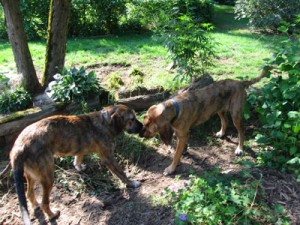Imbolc Waning Moon of the Cold Month
This is the holy day of Bridgit, the triple goddess; she of the eternal fire at Kildare, a goddess who tends to the fire of creativity at home, for the poet and in the smithy, the place where things are made by hand. As with so many things Celtic, the Roman Catholics appropriate her, given her a birth story. Her father, the story goes, was a druid, her mother a good Catholic. She became a Catholic woman known for good deeds and miracles. After her death she became a saint. Many Catholics know her only as St. Bridgit, but her origins as a religious figure had their beginnings and much larger compass within the ancient Celtic faith.
It was the Celts who first tended the eternal fire at Kildare, devoting men and women to the task. Later, in the days of the Celtic Christian church there was a double monastery there, men and women in separate units, abbot and abbess respectively.
Imbolc itself means in-the-belly, referring, as I wrote a few days back, to the lamb in the belly of the ewes. The quickening of the ewes meant fresh milk. After at least three months + of stored food, little meat, and chill weather a small cup of milk or its use in cooking must have been a reason for great celebration. The lambs also were a reminder that the rebirth of spring would come again, just as they had come. Nature’s cycle could be trusted.
We can buy green beans, strawberries, fresh fish, eggs, milk, butter, bread in a brightly lit store. Aisles and aisles of food, so many versions of cereal, peanut butter, spices and salts, rice and pasta, beef, turkey, chicken, pork and, yes, even lamb. In some vague way we know this food arrives at the grocery by truck, packed in cardboard boxes. The workers remove and open the boxes, distributing the food to shelves, meat counters, produce bins, milk coolers. We pick it up, put it in our carts, pay for it, then take it home and store it in cupboards, refrigerators, pantries. Until very recently there was not much attention given, at least by most of us, to the source of the food.
The buy local movement has focused our attention especially on produce and meat. Was the beef grass raised? No antibiotics? The eggs. Were the chickens free range? The leeks and the tomatoes, the lettuce. Who grew it? How far did it travel? Is it organic? Did the salmon come wild from Alaska or farm-raised from the Atlantic?
As we once again allow the blurred image of our food sources to come into focus, I hope we will also allow the blurred images we have of the natural world to come into focus. We may see that the sacred is not a notion found in texts, but in the world. We might feel our way toward the vitality of the dog, the raven, the oak, the tulip, even ourselves, a vitality that emerges, has its day and then absorbs back into the world; the universe represented here, for us, by our planet and its sun, by the web of life sustained by the inanimate, but also sacred world of rocks and water and air and fire.
The Great Wheel, the cycle of solstices and equinoxes broken up the cross-quarter holydays of the Celts: Imbolc, Beltane, Lughnasa and Samhain turn us not outward or upward, not away from ourselves and our world, but inward and downward, toward ourselves and our world. These holydays root us in the changing world, that, paradoxically, changes back into the world of last year, each year. In this sense time for the Great Wheel cycles and recycles, never moving into tomorrow, always returning to yesterday. We need this reminder, the Great Wheel’s reminder, because we are so much in the grip of chronos, the swift moving river of time that sweeps us along towards the gulf of our mortality, a great dead zone at the end of this wonder we call life.
The Great Wheel reminds us that while our life will end, life itself does not. That as we die, a birth occurs. As tears fall, laughter rings out. After the winter, the ewes will freshen, there will be milk. And flowers.

 course) and Vega looks like, well, Vega. She’s a giant coon hound with a huge head and a lot of muscle. Appearances in this case deceive. These girls have been together since last December when they were born.
course) and Vega looks like, well, Vega. She’s a giant coon hound with a huge head and a lot of muscle. Appearances in this case deceive. These girls have been together since last December when they were born.